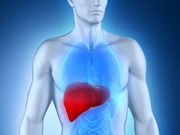More severe hyperinsulinemia, dyslipidemia, and adipose tissue/hepatic insulin resistance with NAFLD
TUESDAY, Feb. 16, 2016 (HealthDay News) — For obese patients with type 2 diabetes mellitus (T2DM), nonalcoholic fatty liver disease (NAFLD) is associated with an unfavorable metabolic profile, according to a study published online Feb. 9 in Diabetes Care.
Romina Lomonaco, M.D., from the University of Florida in Gainesville, and colleagues examined the metabolic consequences of nonalcoholic steatohepatitis (NASH) in patients with T2DM. One hundred fifty-four obese patients were divided into four groups: control (no T2DM or NAFLD); T2DM without NAFLD; T2DM with isolated steatosis; and T2DM with NASH.
The researchers found that with the presence of T2DM and the development of hepatic steatosis, metabolic parameters worsened progressively, with worse hyperinsulinemia, insulin resistance, and dyslipidemia in those with NASH (P < 0.001). NASH correlated with more dysfunctional and insulin resistant adipose tissue compared with isolated steatosis (either as insulin suppression of plasma free fatty acids [FFAs] or adipose tissue insulin resistance index; both P < 0.03). Insulin suppression of plasma FFAs also correlated with hepatic steatosis and steatohepatitis severity (both P < 0.001). Compared with other groups, among patients with T2DM and NASH, hepatic insulin sensitivity was more significantly impaired, both fasting and with increasing insulin levels within the physiological range.
“The unfavorable metabolic profile linked to NAFLD should prompt strategies to identify and treat this population early on,” the authors write.
Copyright © 2016 HealthDay. All rights reserved.








